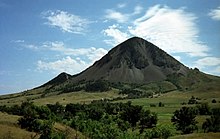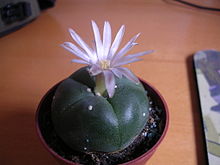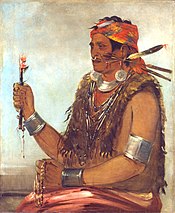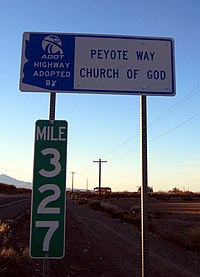Bear Butte, in South Dakota, is a sacred site for over 30 Plains tribes.
Native American religions are the spiritual practices of the indigenous peoples of the Americas. This article focuses on Native North Americans. Traditional Native American ceremonial ways can vary widely and are based on the differing histories and beliefs of individual tribes, clans, and bands. Early European explorers describe individual Native American tribes and even small bands as each having their own religious practices. Theology may be monotheistic, polytheistic, henotheistic, animistic, or some combination thereof. Traditional beliefs are usually passed down in the forms of oral histories, stories, allegories, and principles, and rely on face to face teaching in one's family and community.
Overview
From the 1600s, European Catholic and Protestant denominations sent missionaries to convert the tribes to Christianity. Some of these conversions occurred through government and Christian church cooperative efforts, that forcibly removed Native American children from their families into a Christian/state government-operated system of American Indian boarding schools (aka The Residential Schools) where Native children were taught European Christian beliefs, the values of mainstream white culture, and the English language. This forcible conversion and suppression of Indigenous languages and cultures continued through the 1970s.[1][2][3]As part of the US government's suppression of traditional Indigenous religions, most ceremonial ways were banned for over 80 years by a series of US Federal laws that banned traditional sweat lodge and sun dance ceremonies, among others.[4] This government persecution and prosecution continued until 1978 with the passage of the American Indian Religious Freedom Act (AIRFA).[5]
Some non-Native anthropologists estimate membership in traditional Native American religions in the 21st century to be about 9000 people.[6][7] Since Native Americans practicing traditional ceremonies do not usually have public organizations or membership rolls, these "members" estimates are likely substantially lower than the actual numbers of people who participate in traditional ceremonies. Native American spiritual leaders also note that these academic estimates substantially underestimate the numbers of participants because a century of US Federal government persecution and prosecutions of traditional ceremonies caused believers to practice their religions in secrecy. Many adherents of traditional spiritual ways also attend Christian services, at least some of the time, which can also affect statistics. Since the 80 years of those prior legal persecutions ended with AIRFA, some sacred sites in the United States are now protected areas under law.[8]
Major Native American religions
Earth Lodge Religion
The Earth Lodge Religion was founded in northern California and southern Oregon tribes such as the Wintun. It spread to tribes such as the Achomawi, Shasta, and Siletz, to name a few. It was also known as the "Warm House Dance" among the Pomo. It predicted occurrences similar to those predicted by the Ghost Dance, such as the return of ancestors or the world's end. The Earth Lodge Religion impacted the later religious practice, the Dream Dance, belonging to the Klamath and the Modoc.[9]Ghost Dances
1891 Sioux Ghost Dance. Ghost Dances influenced many Native American religions.
"Ghost Dance" is a very general term that encompasses different religious revitalization movements in the Western United States. In 1870, a Ghost Dance was founded by the Paiute prophet Wodziwob, and in 1889–1890, a Ghost Dance Religion was founded by Wovoka (Jack Wilson), who was also a Northern Paiute. The Ghost Dance was meant to serve as a connection with traditional ways of life and to honor the dead while predicting their resurrection.[9]
In December 1888, Wovoka, who was thought to be the son of the medicine man Tavibo (Numu-tibo'o), fell sick with a fever during an eclipse of the sun, which occurred on January 1, 1889. Upon his recovery, he claimed that he had visited the spirit world and the Supreme Being and predicted that the world would soon end, then be restored to a pure aboriginal state in the presence of the Messiah. All Native Americans would inherit this world, including those who were already dead, in order to live eternally without suffering. In order to reach this reality, Wovoka stated that all Native Americans should live honestly, and shun the ways of whites (especially the consumption of alcohol). He called for meditation, prayer, singing, and dancing as an alternative to mourning the dead, for they would soon resurrect. Wovoka's followers saw him as a form of the messiah and he became known as the "Red Man's Christ."
Tavibo had participated in the Ghost Dance of 1870 and had a similar vision of the Great Spirit of Earth removing all white men, and then of an earthquake removing all human beings. Tavibo's vision concluded that Native Americans would return to live in a restored environment and that only believers in his revelations would be resurrected. This religion spread to many tribes on reservations in the West, including the Shoshone, Arapaho, Cheyenne, and Sioux (Dakota, Lakota, and Nakota). In fact, some bands of Lakota and Dakota were so desperate for hope during wartime that they strengthened their militancy after making a pilgrimage to Nevada in 1889–1890. They provided their own understanding to the Ghost Dance which included the prediction that the white people would disappear. A Ghost Dance gathering at Wounded Knee in December 1890 was invaded by the Seventh Cavalry, who massacred unarmed Lakota and Dakota people.[10]
The earliest Ghost Dance heavily influenced religions such as the Earth Lodge, Bole-Maru Religion, and the Dream Dance. The Caddo Nation still practices the Ghost Dance today.[11]
Indian Shaker Religion
Also known as Tschida, the Indian Shaker Religion was influenced by the Waashat Religion and founded by John Slocum, a Squaxin Island member. The name comes from the shaking and twitching motions used by the participants to brush off their sins. The religion combines Christianity with traditional Indian teachings. This religion is still practiced today in the Indian Shaker Church.[9]Longhouse Religion
This replica of a Six Nations (Haudenosaunee) longhouse represents where the traditional practices take place.
The Longhouse Religion, founded in 1799 by Seneca Handsome Lake, revitalized Native American religion among the Iroquois. The doctrine of the Longhouse Religion also called the Handsome Lake Religion is the Gaiwiio, or "Good Word".[12] Gaiwiio combines elements of Christianity with long-standing Iroquois beliefs. The Longhouse Religion is still practiced by Six Nations people today.
Mexicayotl
Mexicayoal (Nahuatl word meaning "Essence of the Mexican", "Mexicanity"; Spanish: Mexicanidad; see -yotl) is a movement reviving the indigenous religion, philosophy and traditions of ancient Mexico (Aztec religion and Aztec philosophy) amongst the Mexican people.[13]
The movement came to light in the 1950s, led by Mexico City intellectuals, but has grown significantly on a grassroots level only in more recent times, also spreading to the Chicanos of North America.[14] Their rituals involve the mitotiliztli.[15] The followers, called Mexicatl (singular) and Mexicah (plural), or simply Mexica, are mostly urban and suburban people.[14]
The Mexicayotl movement started in the 1950s with the founding of the group Nueva Mexicanidad by Antonio Velasco Piña. In the same years, Rodolfo Nieva López founded the Movimiento Confederado Restaurador de la Cultura del Anáhuac,[16] the co-founder of which was Francisco Jimenez Sanchez who in later decades became a spiritual leader of the Mexicayotl movement, endowed with the honorific Tlacaelel. He had a deep influence in shaping the movement, founding the In Kaltonal ("House of the Sun", also called Native Mexican Church) in the 1970s.[17]
From the 1970s onwards Mexcayotl has grown developing in a web of local worship and community groups (called calpulli or kalpulli)[14] and spreading to the Mexican Americans or Chicanos in the United States. It has also developed strong ties with Mexican national identity movements and Chicano nationalism.[18] Sanchez's Native Mexican Church (which is a confederation of calpullis) was officially recognized by the government of Mexico in 2007.[19]
Native American Church
Peyote's illegal status in the United States prevents non-Natives from participating in peyote ceremonies.
The Peyote Religion legally termed and more properly known as the Native American Church has also been called the "Peyote Road" or the "Peyote Way", is a religious tradition involving the ceremonial and sacred use of Lophophora williamsii (peyote).[20] Use of peyote for religious purposes is thousands of years old and some have thought it to have originated within one of the following tribes: the Carrizo, the Lipan Apache, the Mescalero Apache, the Tonkawa, the Karankawa, or the Caddo, with the Plains Cree, Carrizo, and the Lipan Apache being the three most likely sources. In Mexico the Huichol, Tepehuán, and other Native Mexicans use peyote.[21] Since then, despite several efforts to make peyote ceremonies illegal, ceremonial peyote use has spread from the Mexico area to Oklahoma and other western parts of the United States.[22] Notable Native American Church (NAC) members include Quannah Parker, the founder of the NAC, and Big Moon of the Kiowa tribe.
Waashat Religion
The Waashat Religion is also called the Washani Religion, Longhouse Religion, Seven Drum Religion, Sunday Dance Religion, Prophet Dance, and Dreamer Faith. The Wanapam Indian Smohalla (c. 1815–1895) used wáashat rituals to build the religion in the Pacific Northwest. Smohalla claimed that visions came to him through dreams and that he had visited the spirit world and had been sent back to teach his people. The name waasaní spoke to what the religion was about; it meant both dancing and worship.[23] He led a return to the original way of life before white influences and established ceremonial music and dancing. Smohalla's speaking was called Yuyunipitqana for "Shouting Mountain".[9]The Dreamer Faith, and its elements of dancing, foreshadowed the later Ghost Dances of the plains peoples.[23][23] It was a back–to–our–heritage religion.[23] Believers thought that white people would disappear and nature would return to the way it was before they came.[23] To achieve this, the Natives must do the things required by the spirits, like a Weyekin.[23] What the spirits wanted was to throw off violent ways, cast off white culture, and not buy, sell or disrespect the Earth.[23] They must also dance the Prophet Dance (wáashat).[23]
The religion combined elements of Christianity with Native beliefs, but it rejected white-American culture.[23] This made it difficult to assimilate or control the tribes by the United States.[23] The U.S. was trying to convert the Plains tribes from hunter-gatherers to farmers, in the European-American tradition.[23] They wanted to remake the Natives but found a problem with those who followed the Dreamer Cult: "Their model of a man is an Indian ...They aspire to be Indian and nothing else."[23]
Prophets of the movement included Smohalla (of the Wanapam people), Kotiakan (of the Yakama nation) and Homli (of the Walla Walla).[23] Their messages were carried along the Columbia River to other communities.[23] It is unclear exactly how it started or when Christianity influenced the earlier form, but it is thought to have something to do with the arrival of non-Indians or an epidemic and a prophet with an apocalyptic vision. The Waashat Dance involves seven drummers, a salmon feast, use of eagle and swan feathers and a sacred song sung every seventh day.[9]
Ceremonies
Sun Dance
The sun dance is a religious ceremony practiced by a number of Native American and First Nations Peoples, primarily those of the Plains Nations. Each tribe that has some type of sun dance ceremony has their own distinct practices and ceremonial protocols. In many cases, the ceremony is held in a private and is not open to the public. Most details of the ceremony are kept from public knowledge out of great respect for, and the desire for protection of, the traditional ways. Many of the ceremonies have featured in common, such as specific dances and songs passed down through many generations, the use of traditional drums, the sacred pipe, praying, fasting and, in some cases, the piercing of the skin.In Canada, the Plains Cree call this ceremony the Thirst Dance; the Saulteaux (Plains Ojibwe) call it the Rain Dance; and the Blackfoot (Siksika, Kainai, and Piikani) call it the Medicine Dance. It is also practiced by the Canadian Dakota and Nakoda, and the Dene.
Religious leaders
Leaders in Native religions include Popé, who led the Pueblo revolt in 1675, Quautlatas, who inspired the Tepehuan Revolt against the Spanish in 1616, Neolin, Tenskwatawa, Kenekuk, Smohalla, John Slocum, Wovoka, Black Elk and many others.
Tenskwatawa, by George Catlin.
From time to time important religious leaders organized revivals. In Indiana in 1805, Tenskwatawa (called the Shawnee Prophet by Americans) led a religious revival following a smallpox epidemic and a series of witch-hunts. His beliefs were based on the earlier teachings of the Lenape prophets, Scattamek and Neolin, who predicted a coming apocalypse that would destroy the European-American settlers.[24] Tenskwatawa urged the tribes to reject the ways of the Americans: to give up firearms, liquor, American style clothing, to pay traders only half the value of their debts, and to refrain from ceding any more lands to the United States. The revival led to warfare led by his brother Tecumseh against the white settlers.[25]
Congressional legislation affecting Native American religion
Sign for a Native American church







